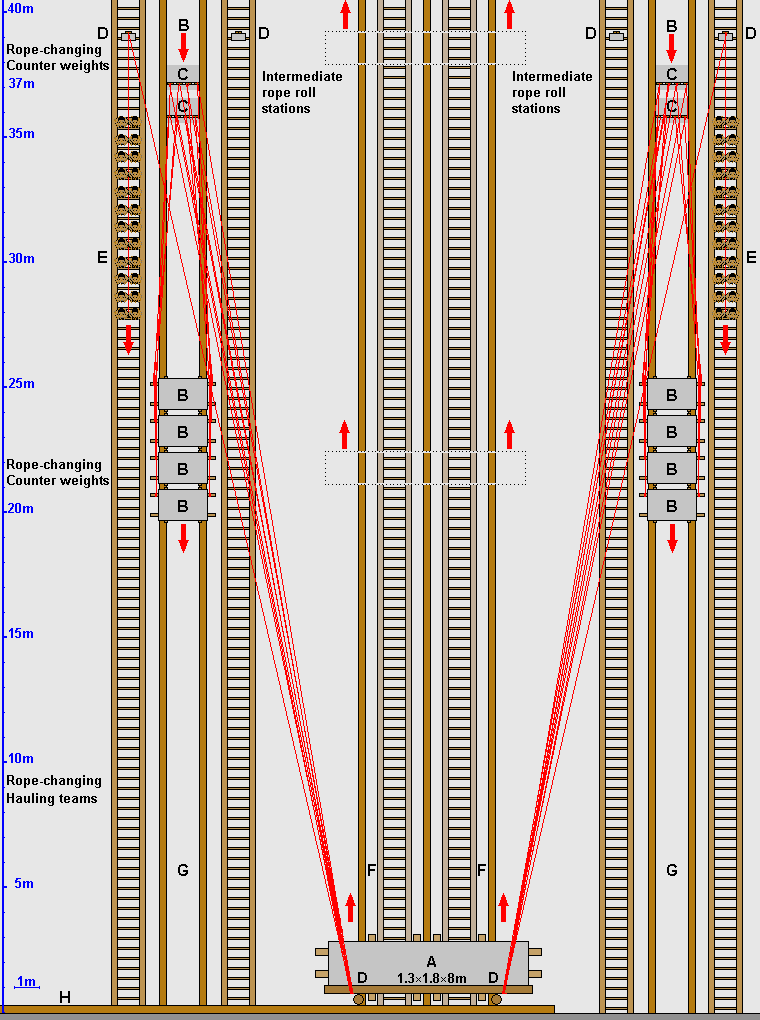How were the pyramids built?
Lifting the granite blocks with a heavy duty track system with counter weights
A new method by Franz Löhner
How were the huge 50-tons granite beams brought up to more than 40 meters
height (25th to 85th stone course) so they could be used for the construction
of the King's Chamber and the Grand Gallery?
Solution for transport problems - Harbor
to pyramid - Large standard sized blocks as
counterweights - Exact method of operation
- Placement of components
- Starting the sledge - Up
the pyramid flank - Position of rope-roll-stations
- Intermediate rope roll stations -
Last rope roll station on edge - Sources
 How to solve the transport problems
How to solve the transport problems
In the pyramid of Khufu the hard granite stones were used in the interior
for the Grand Gallery and the King's chamber as well as for the sarcophagus.
Huge granite beams weighting 48 to 52 tons (1.3 x 1.8 x 8m with a density
of 2,6 - 2,8 g/cm³) were used for the King's chamber. The pyramid
temple had granite columns and an extensive basalt pavement was layed
down around the pyramid [1].
![]() The pyramid of Khufu and its chambers
and shafts
The pyramid of Khufu and its chambers
and shafts
![]() Cutting granite with iron tools
Cutting granite with iron tools
A lot of methods for transporting, that just barely work for the normal
2.5-tons stone blocks, don't work for these heavyweights. If you distribute
the enormous weight on several rope roll stations this problem
can also be solved.
![]() Ramp models described in details
Ramp models described in details
| 1. | New | The granite blocks were cut in the quarry of Aswan to the dimension and shape ordered. So when they arrived in Giza, they could be transported to the foot of the pyramid and then up the flank without any stopovers whatsoever (doctrine = the granite beams were cut to size on the pyramid). |
| 2. | New | For the granite blocks a separate route which goes from the harbor to the pyramid and up the flank (probably on the eastern side) is installed with tracks and rope roll stations. |
| 3. | New | The large granite beams were brought up to the height needed with a heavy duty track system with stone blocks as counter weights (doctrine = the granite blocks were transported on ramps or they were levered with wooden levers from one stone course up to the next, every time a course was added) |
 From the harbor to the pyramid
From the harbor to the pyramid
The large granite blocks arrived in the harbor of Giza (the Nile channel
lies on approx. 17m above sea level, the exact position of the harbor
is unknown) and had to be transported over a distance of 500-600
meters and overcome 40 meters difference in
height to the foot of the pyramid. Most of the route is not very steep
- the average angle of inclination is about 4° - but there are some
stretches with 8° to 24° inclination, that have to be negotiated,
until you reach the rock plateau at the base of the pyramid.
![]() The pyramid building yard (illustration
of differences in height)
The pyramid building yard (illustration
of differences in height)
For the granite blocks a separate route which goes from the harbor to the foot of the pyramid is installed with heavy tracks and rope roll stations about every 75 meters. The weight of the huge stone blocks is distributed among more rope rolls and of course for these large weights you need more haulers per team. It is also possible, that instead of two hauling teams per section there were four teams with ropes of different lengths, so they could walk one team behind the other. The granite beams are hauled up lengthwise to produce less friction. We calculate that eeven when using rope rolls you need between 300 and 500 haulers for a 40 tons stone.
 Large standard sized blocks as counterweights
Large standard sized blocks as counterweights
On the pyramid flank Franz Löhner's rope rolls can also be used for the heavyweights, but not only with humans as haulers. A 50 tons load including the sledge (300kp) would demand more than 670 haulers, even if using rope rolls. Actually this large number could be put to haul, if you make groups of 30 haulers using 23 rope rolls, but it can also be done more smartly, more economical and with less risk.
After all, on 21 meters height where you start to use granite blocks for the Grand Gallery, there are enough limestone blocks lying around to be let slide down the flank as counterweights. To counterbalance a granite block of 50 tons you need 8 limestone blocks of 5.6 tons (2m x 1.2m x 0,9m at 2,6g/cm³), that was a common weight for larger blocks used while building Khufu's pyramid. These 8 blocks are hauled up in the usual way and then used as counterweights until all the 90 heavyweight granite beams are hoisted up. If you take in count, that over 2'300 000 stone blocks were moved in total, you must realize, that moving those blocks was a ludicrous minor additional effort.
 Exact method of operation
Exact method of operation
On the pyramid flank (probably on the eastern side) a heavy duty track system with counterweights is installed. This track system consists of three (not two) rails and an additional pair of rails to the left and to the right for the stones serving as counterweights. Then ladder-like rigs for the hauling teams are also installed on each side. Additional ladder-like rigs are installed between the main rails for the men controlling the ascend of the granite beam.
To haul the heavy granite blocks up the pyramid flank it is very important to plan each step and only use the most experienced hauling teams. The granite block should move up the flank on the tracks in one uninterrupted movement. Every time the sledge with the stone has to be stopped and started again it uses a lot of force because you have to overcome the static friction (stiction). To hoist the block over the edge to the pyramid plateau an additional team operating on the pyramid frustum is used.
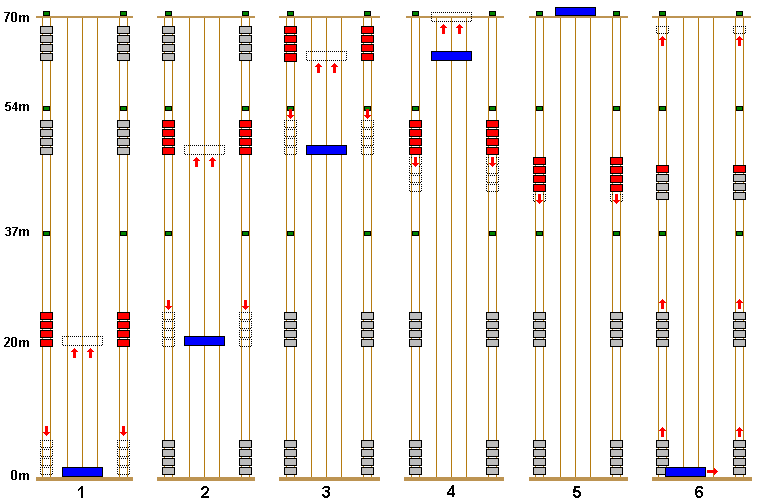
Illustration of the procedure to lift a granite beam up to the edge of the pyramid plateau (here on 65m) by using counter weights on a heavy duty track system (Granite Beam / Counterweights / Intermediate Rope-Roll-Station). Hauling teams are not shown.
1. The granite beam (blue) lies on a sledge at the foot of the pyramid, the 8 counterweights on sledges (red) are anchored below the first intermediate rope-roll-station (green) on 20-25m. The counterweights are slowly released and glide down while the granite beam is lifted to the height of the first intermediate rope-roll-station.
2. The counterweights have arrived at the foot of the pyramid and are stopped just shortly before they reach the ground. At the same time the second series of counterweights start to move down, sliding over the first intermediate rope-roll-station and stopping a short distance further down (they could be lowered more, but for safety reasons the ropes shouldn't be too long).
3. The third series of counterweights starts to move and slides over the second intermediate rope-roll-station.
4. When the granite beam has reached the edge of the pyramid plateau, the counterweights are slowed on their way down and nearly stopped.
5. At the edge there is an additional hauling team which is hauling on the pyramid plateau and the granite beam is carefully lifted over the edge with the help of levers.
6. The ropes attached to the granite beam are released and each counterweight stone is hauled up separately to its starting position by hauling teams (the upper stone series first) and the next granite beam is brought to the base of the pyramid.
 Placement of the individual components of the heavy duty track system
Placement of the individual components of the heavy duty track system
Illustration - with and without ropes (mouse over)
To scale / cross-beams used to anchor the tracks are omitted
Granite beam (A) / Counterweights (B)
/ Intermediate rope-roll-stations for the counterweights (C)
/ Rope-roll-stations (D) for the hauling teams (E)
/ Rails and ladder-like rig to secure the granite beam (F)
/ Rails and ladder-like rig to secure the counterweights (G)
/ Rails for transporting the granite beam from the harbor to the pyramid
(H)
The granite beam (A)
- The huge granite beams (A) weight 48 to 52 tons (1.3 x 1.8 x 8m with a density of 2,6 - 2,8 g/cm³)
- The sledge is originally attached to the granite beam in such a way that it can be hauled up from the harbor lengthwise. At the base of the pyramid the rigging of the sledge is changed so it can be hauled up directly up the flank of the pyramid
- The granite beam is hauled up widthwise so it is easier to haul it over the edge to the pyramid plateau
The counterweights (B)
- Large standard stone blocks are used as counterweights (B), each weighting about 5.6 tons (2m x 1.2m x 0,9m with a density of 2,6 - 2,8 g/cm³)
- Each counterweight stone (B) is also attached widthwise on a sledge. In this position they take up less room on the tracks. This is specially important when bringing large stones up to lower heights
- The sledges are positioned only a short distance apart and their track system (G) is separated from the main track system for the granite stones by a few meters
- Because the counterweights have to move together on the tracks as an unit, they are connected by a rigid but removable framework
- Eine erste Zwischenstation (C) ist auf 37m Höhe angelegt
- The first intermediate rope-roll-station (C) is installed on 37meters
- If the granite beam has to be lifted to a height of more than 37m, a second series of counterweights is lowered from the second intermediate rope-roll-station (for example on 54m which is the same height as the relieving chambers) or from the edge to the pyramid plateau
- After the granite block has reached the edge to the pyramid plateau all the counterweights are separately hauled back to their starting position by hauling teams (E)
The hauling teams (E)
- Although the counterweights (B) counter-balance a large part of the weight of the granite beam (A), a team of haulers (E) is still necessary to lift the difference in weight
- This difference is, depending on the size of the granite beam, from 3.2 to 7.2 tons (48-52t minus 44.8t)
- This works out to 1.6 to 3.6 tons for each of the two hauling teams to the left and right of the main track system. Our calculations show, that we need between 32 and 64 haulers per team
- It is also important, that the hauling teams control with which speed the granite beam is ascending and the counterweights are descending
Tracks and ladder-like rigs (F)
- For the granite block three rails lie close to each other are used
- Additional ladder-like rigs (F) are installed between the main rails for the men controlling the ascend of the granite beam
- For the counterweights (B) a separate track system (G) is installed to the left and right
- For the hauling teams (E) and the team securing the counterweights there is also a ladder-like rig installed
Position of the intermediate rope-roll stations (C and D)
- Up to 30-37 meters height [4] rope roll stations on the edge to the plateau are used
- Above this height two intermediate rope-roll-stations (C) each are permanently installed one on top of the other. Their exact position has to take in count, that the ropes between the granite beam (A) and the counterweights (B) have to be moved evenly (otherwise the sledge with the counterweights might tilt and slip off the tracks)
- The intermediate rope-roll-stations (C) have to be positioned laterally several meters so the descending counterweights and the ropes attached to the beam and those attached to the counterweights don't interfere with each other
- For safety reasons the two rope roll stations (D) for the hauling teams (E) are also installed separately to the left and right
- Furthermore the rope-roll stations (D) for the hauling teams (E) are built a few meters on top of the intermediate rope-roll-station (C) so the ropes don't get entangled with the counterweight sledges
Position of the rope rolls in the intermediate rope-roll-stations (C)
- Because the sledge with the counterweights from the second rope-roll station has to slide over the lower intermediate rope-roll-station when descending, those rope roll stations may not jut out to much from the pyramid flank
- This is solved by placing the intermediate rope-roll-stations one above the other and placing the rope rolls side by side on a ledge which only juts out a little (20cm) from the pyramid lateral surface
The ropes
- The way the ropes are arranged has to be planned with special diligence because the numerous ropes should on no account get entangled or chafe on the stones. They also should not hamper the hauling teams
- For safety reasons any area on the stones, sledges and also every other place the ropes could possibly rub against or chafe, is covered with a piece of leather that is slightly oiled
- For safety reasons the ropes are all doubled
- The length of the ropes is 50 to maximum 70 meters
- Changing the ropes (ropes from the upper rope roll station are attached) of the counterweights is taking place on about 20 meters height
- In contrast changing the ropes for the hauling teams is taking place when the teams nearly have reached the base of the pyramid
 Starting the sledge at the foot of the pyramid
Starting the sledge at the foot of the pyramid
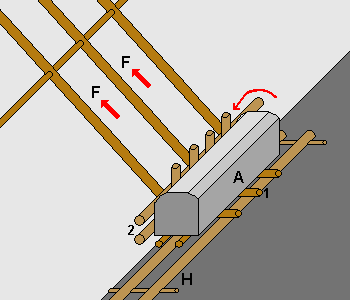 Three
tracks (F) are built going up the pyramid flank and the
tracks (H) coming from the harbor are lengthened until
they reach the base of the pyramid. On the side where the sledge (1)
nearly touches the outer stones of the pyramid another sledge (2)
is attached. The granite beam (A) now lies lengthwise
on the second sledge so it can be hauled up the pyramid flank
widthwise. Now it has to be carefully tilted with the help of
levers so it lies flat on the tracks going up the pyramid flank. Nine
double ropes are attached. For extra safety double ropes are used, this
is no problem for the rope rolls. The double ropes go to the next rope
roll station where a total of 8 rope rolls each are installed on special
Tura stones on each side. As counterweights 5.6-tons-blocks on sledges,
are each hanging on the ropes, ready to glide down to the foot of the
pyramid. With this arrangement 8 times 5.6 tons which adds to
44.8 tons can be lifted with the counterweights. The difference
(with a 50 tons stone this would be 5.2 tons) is lifted by hauling teams
which walk down to the right and left of the tracks on a ladder-like rig.
For safety reasons separate rope roll stations are used for the hauling
teams.
Three
tracks (F) are built going up the pyramid flank and the
tracks (H) coming from the harbor are lengthened until
they reach the base of the pyramid. On the side where the sledge (1)
nearly touches the outer stones of the pyramid another sledge (2)
is attached. The granite beam (A) now lies lengthwise
on the second sledge so it can be hauled up the pyramid flank
widthwise. Now it has to be carefully tilted with the help of
levers so it lies flat on the tracks going up the pyramid flank. Nine
double ropes are attached. For extra safety double ropes are used, this
is no problem for the rope rolls. The double ropes go to the next rope
roll station where a total of 8 rope rolls each are installed on special
Tura stones on each side. As counterweights 5.6-tons-blocks on sledges,
are each hanging on the ropes, ready to glide down to the foot of the
pyramid. With this arrangement 8 times 5.6 tons which adds to
44.8 tons can be lifted with the counterweights. The difference
(with a 50 tons stone this would be 5.2 tons) is lifted by hauling teams
which walk down to the right and left of the tracks on a ladder-like rig.
For safety reasons separate rope roll stations are used for the hauling
teams.
![]() Transport up the pyramid flank with Löhner's
rope roll
Transport up the pyramid flank with Löhner's
rope roll
Now high up, at the intermediate rope-roll-stations, the blocking devices which held the sledges with the counterweight stones in place are removed one after the other. On the outer side of the track system the hauling teams get ready. After a last check the ropes tauten and at the base of the pyramid men with levers push the sledge with the granite beam so it starts moving up the tracks. The sledges with the stones are moving slowly and deliberately, since it is important to keep all the sledges aligned on the tracks. Any jerk or jolt could unbalance the whole contraption, something which would be extremely dangerous.
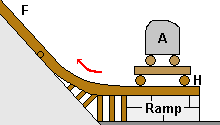 Shorter
hauling distances
Shorter
hauling distances
Up to 30-37 meters height, rope roll stations on the edge to the plateau
of the pyramid are used. When starting the sledge with the granite beam
from the base of the pyramid, a slightly different approach is used. Since
the counterweights will take up some room when arriving from above, an
auxiliary ramp about a meter high has to be built at the base of the pyramid
where the tracks start. The track system coming from the harbor is lengthened
up this ramp. The sledge with the granite stone lying lengthwise, is hauled
up the ramp and on a piece of rail (H) which is a bit
longer than the stone, this piece is detachable. The sledge with the stone
is attached to this piece of rail, which now forms the crossbars of the
sledge. The auxiliary ramp has to be built about a meter distance from
where the outer stones reach the foot of the pyramid, so the sledges with
the counterweights have enough space todescend to ground level. This gap
is bridged with a massive support frame made from wood.
 Up the pyramid flank
Up the pyramid flank
All sledges are accompanied by overseers ready to stop the sledges if there is any danger. Others are carrying long poles which are oiled at the tip and are checking the numerous ropes, lifting some of them carefully with poles which are covered in front with slightly oiled leather, so they don't get entangled. For each rope roll station there is one man in charge and the sledge with the granite stone is accompanied by several men carrying stopping devices (wooden triangles). The workers are secured above with ropes so they can move fast and are using the ladder-like rigs between the main tracks.
The length of the ropes has to be calculated, that the moment the counterweights reaches the base of the pyramid next to the starting tracks, the granite sledge would reach about 25 meters height. Somewhat earlier, about at 20 meters the ropes are changed. That is to say, the ropes of the second intermediate rope-roll-station (with shorter hauling distances the ropes were not changed) are uncoupled and the ropes coming from the next station attached. The counterweights from the second station are set in motion, gliding past and over the intermediate rope-roll-station and are stopped shortly after. In such a way all heavy stone blocks can be lifted to the required height.
 Position of the intermediate rope-roll-stations
Position of the intermediate rope-roll-stations
The largest stones were used for the Grand Gallery, the King's chamber and the relieving chambers. Additional large stones were used for the entrance, the Queen's chamber and the corridors. So the first heavyweights were needed at 20m (Queen's chamber and entrance), the last stones on 66m or more (= known height of the gable of the upper most relieving chamber [5]).
It is incidental that several intermediate rope-roll-stations
should be installed permanently. The main intermediate rope-roll-station
had to be situated between 30 and 37 meters [4],
because this is where the King's chamber is built. Additional rope-roll-stations
were installed with a difference in height of about 20 meters, so the
granite beams could be brought up high enough. Khufu's pyramid has specially
thick stone layers which could be used to install rope roll stations on
17m / 30m (+13m) / 37m (+7m) / 54m (+17m) / 69m (+15m) / 75m (+6m) / 89m
(+14m) / 105m (+16m) / 125m (+20m) and probably shortly before the top
of the pyramid [2].
![]() Stone courses of the Pyramid of Khufu
Stone courses of the Pyramid of Khufu
 The intermediate rope roll stations
The intermediate rope roll stations
Unlike a standard block, the granite block is tied widthwise on the sledge, so it is wider and taking up more room. This is the reason why the rope roll stations have to be installed several meters apart to the left and right of the track system in the middle. For the hauling team a separate rope roll station is used.
For the 4 counterweight stones a total of 8 rope rolls are needed per
station. These are installed always 4 rope rolls next to each other on
a ledge. With standard stones the sledge passes between the two rope rolls
tied to protruding stone bosses. But with the heavy duty track system
the sledges with the counterweights coming down from the second station
above (or on the edge) have to glide over the intermediate rope
roll station. This is the reason, why the rope rolls and Tura
stones should protrude only slightly from the side surface of the pyramid.
![]() Transport up the pyramid flank with Löhner's
rope roll
Transport up the pyramid flank with Löhner's
rope roll
This problem can be solved if we use a shorter wooden rope roll (20cm instead of 35cm long). Now the ledge of the Tura stone where the 8 rope rolls lie on top can also be much narrower. To anchor these rope rolls soundly, the Tura stone on top of this stone layer is cut in such a form, that they are clamped between the two stones. The ledge together with the upper stone form a kind of cross-sill.
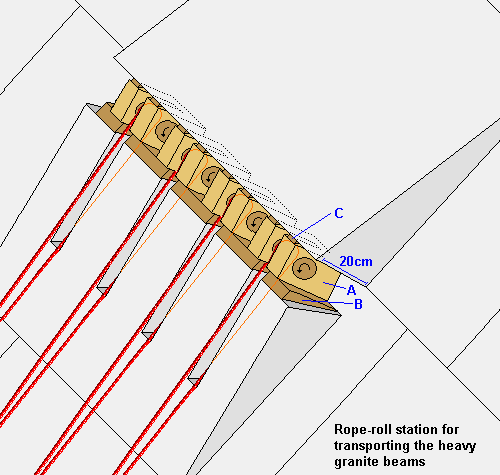
The sledge with the counterweights slide down from above on rails made with round logs, which lie to the left and right of the rope roll station. The logs are quite thick, so the sledge can easily glide over the elevation of 20cm which the rope roll station represents. The sledge doesn't even touch the wooden rope rolls!
Care should be taken, because the Tura stone is not so resilient. Specially at the places where the rope roll is placed on the stone, a lot of force is applied. With several rope rolls in a row, pressures of more than 30 tons are generated, however not uniformly but with punctiform points of contact. These stresses can cause cracks in the supporting stone underneath. This can be solved by placing a long wooden board (B) on the stone underneath the rope rolls (A), so the force is applied more uniformly. This board has slots so the ropes don't chafe. The upper Tura-stone is slightly overhanging and every rope roll is firmly lodged in between the stones with a wedge (C).
 To
facilitate handling the ropes, the 4 rope rolls of the upper (2)
and lower series (1) are slightly offset laterally
against each other and the rails for the counterweights go past
the station to the right and left.
To
facilitate handling the ropes, the 4 rope rolls of the upper (2)
and lower series (1) are slightly offset laterally
against each other and the rails for the counterweights go past
the station to the right and left.
The upper stones (2) are also slightly higher so the ropes (blue) can stretch over the lower stone and don't chafe against it. The area (red arrow), where the ropes could possibly chafe are under laid with leather, so there is no friction.
The additional expenditure to construct such a solid track system and large rope roll stations is well worth it, because it will be used to transport all granite blocks up the pyramid flank - more precisely all the material used to construct the King's chamber which lies between 43 and 65m (= height of the roof). After all the granite beams are incorporated and the intermediate rope roll stations are not used any more, the protruding Tura stones are simply beveled to the appropriate angle and no sign of the station is visible anymore on the surface of the pyramid.
 The last rope roll station on the edge
The last rope roll station on the edge
The last rope roll station, the one at the top of the frustum of pyramid, was positioned on the very edge. A specially large Tura stone (1) with 9 rope rolls (A, B and C) protrudes out over the edge to the pyramid plateau.
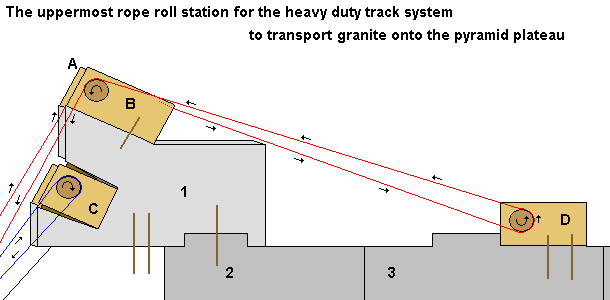
The special Tura-stone is anchored with some poles rammed into the stone underneath (2). This stone has been cut to such a shape, that it interlockes with the Tura-stone above with the help of a peg. This helps, that the large Tura-stone (1) tilts and is pulled from its place by the weight of the granite beam. The Stone is cut in such a way, that 5 roperolls are positioned on top and 4 roperolls in a ledge underneath.
A third rope roll (D) is placed about one and a half meters back on the plateau and anchored by another protruding stone (3) and some poles rammed into the stone underneath.
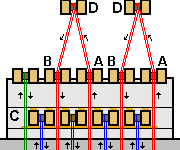 Now
it is specially important, how the ropes are directed over the roperolls.
Nine ropes are attached to one side of the sledge with the granite beam.
Two ropes (red) each are
taken together and directed over the upper rope roll
(A) and then underneath the second rope roll
(D), then back over another upper rope
roll (B) and down to the counterweights. The
rope rolls lie very close to each other and a total of 4 ropes are redirected.
Another four ropes (blue)
lead over lower the rope rolls (C) installed
on a ledge in the special Tura stone. These rope rolls are shorter and
firmly wedged in. One rope (green
- only shown on the small illustration) leads up from the granite sledge
to a rope roll and back to the hauling team.
Now
it is specially important, how the ropes are directed over the roperolls.
Nine ropes are attached to one side of the sledge with the granite beam.
Two ropes (red) each are
taken together and directed over the upper rope roll
(A) and then underneath the second rope roll
(D), then back over another upper rope
roll (B) and down to the counterweights. The
rope rolls lie very close to each other and a total of 4 ropes are redirected.
Another four ropes (blue)
lead over lower the rope rolls (C) installed
on a ledge in the special Tura stone. These rope rolls are shorter and
firmly wedged in. One rope (green
- only shown on the small illustration) leads up from the granite sledge
to a rope roll and back to the hauling team.
Special care has to be taken, when the granite beam is tilted over the edge onto the pyramid plateau. But because the beam is hauled up the pyramid flank widthwise, this is not that difficult. To accomplish a smooth tilting, the ropes are attached to the rearmost bar of the sledge shortly before reaching the edge. Of the double ropes one is passed above, the other rope below the anterior bar of the sledge. Directly before the edge additional ropes are attached to the anterior bars and a hauling team positioned on the plateau itself helps to accelerate the tilting.
Tilting the stone is controlled very precisely, so the sledge doesn't
hit the edge. Two strong round wooden logs are placed on ropes which are
stretched across and held by two strong men, so the impact of the beam
can be cushioned. Overseers standing just at the edge of the pyramid are
giving precise instructions as to how to level the sledge. Once on the
pyramid plateau the stone is transported by hauling teams on oiled tracks
to its intended place, for example to the construction site of the King's
chamber.
![]() Transport up the pyramid flank
with Löhner's rope roll (Details how it was tilted over the edge)
Transport up the pyramid flank
with Löhner's rope roll (Details how it was tilted over the edge)
Now all you have to do is to get the counterweights up to their starting
position again and tie them down until they are used again. The hauling
teams pull those stone blocks up one by one in the usual way - on the
same track where they have been lowered. There was plenty of time to do
that, because the granite beams arrived from Aswan only occasionally,
not every day.
![]() Quarrying stones for the pyramid
Quarrying stones for the pyramid
![]() Shipping
the stone blocks down the Nile to Giza
Shipping
the stone blocks down the Nile to Giza
 Sources
Sources
These methods for building the pyramids were first published 1993 in the book "Der Bau der Cheops-Pyramide" by Heribert Illig and Franz Löhner.
[1] D. Arnold Lexikon
der Ägyptischen Baukunst
[2] W. Petrie The Pyramids and Temples
of Gizeh (Levels of the Courses of the Great Pyramid)
[3] H. Illig und F. Löhner Der
Bau der Cheops-Pyramide
| Copyright 2006: |
Franz Löhner www.cheops-pyramid.ch | |
| Concept and Design, English Texts: |
Teresa (Zubi) Zuberbühler www.starfish.ch |
